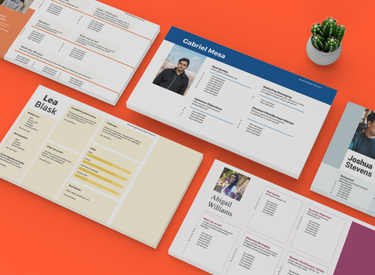The other ad felt like it was looking me dead in the eye. It was for an SEO software that I already use, beckoning me to join an upcoming webinar with the text “Get your website traffic back.” As an SEO writer, webinars like this are like catnip to me. It wasn't an accident, either: this company understands my segment of their audience.
Bullseye marketing like this is the result of buyer personas. As a consumer, I appreciate the investment the company made in understanding me. As a marketer, I know that their marketing dollars would be gambled on guesswork without it.
I've created eight buyer persona examples that illustrate the best practices and uses. Let me show you the how and why behind their design (and even sample ads generated with each one!) to get your gears spinning for your own persona creation.
In this article, I'll share my framework and eight original examples.
Table of Contents
- What is a buyer persona?
- Why Buyer Personas Are Essential to Your Business Growth
- How to Create Buyer Personas: An Actionable Playbook
- 8 Buyer Persona Examples to Inspire Yours
What is a buyer persona?
A buyer persona (aka a customer or user persona) is a fictional representation of your ideal customer. Marketing, support, and sales teams use this to interact with customers in a way that makes them feel instantly understood.
Creating personas starts with deep research on both your existing and potential customers. Take customer data and market research, then add details like the buyers' demographics, pain points, motivations, expectations, and constraints.
Companies have specific personas for specific products and customer segments. This is natural, given that every segment will have unique priorities, goals, challenges, and even demographics. For example, let‘s say I’m an ideal customer for the clothing brand Patagonia. Marketers would need two separate personas to sell me a winter puffer jacket in the winter versus a pair of summer shorts because my needs and motivations would be different.
So, how does persona-based marketing feel to the customer? Jake Victor, a copywriter and growth strategist, perfectly summarizes how persona-focused marketing makes people feel like “this is for me.”

I‘ve designed strategic marketing campaigns for online businesses, government offices, and nonprofits. If there’s one important thing I‘ve learned, it’s this: The most effective marketing is done by brands that are obsessed with knowing their audience. Let's look at how you can become that brand.
Why Buyer Personas Are Essential to Your Business Growth
Sure, buyer personas help companies create personalized campaigns. But the value of these fictional profiles goes far beyond that. Here‘s why they’re powerful for long-term growth.
1. Brand Positioning
When you think of healthy fast food, what brand comes to mind? For many, it's Subway. Or what about a relaxing night in at home? Netflix. Looking to refresh your living room? IKEA.
These brands have earned a reputation as the go-to solution for specific pain points thanks to their successful positioning. Nail this for your brand, and your marketing team can more easily:
- Write compelling copy and content that makes them feel seen and understood.
- Design user experiences tailored to specific aspirations and challenges.
- Craft relatable campaigns to stress buyers' pain points.
Strong brand positioning relies on understanding exactly who you're positioning for. That's where buyer personas come in. This clarity on positioning needs will guide you in designing a customer journey.

2. Customer Journey
Marketers work extremely hard (and spend millions of dollars) trying to convince customers to think of their brand a certain way. These efforts sometimes stick: like Subway telling us to “eat fresh” in the early 2000s.
But no matter how catchy a campaign is, marketing will always stand in the shadow of the lived user experience. Like Subway patrons learning there‘s so much sugar in Subway’s bread that it isn't legally classified as bread in some countries.
Brands can't dictate what consumers will think of them. Instead, marketers have to follow the journey that the customer takes when forming an opinion of them, and optimize these touchpoints for success.
3. Cross-Functional Alignment
I‘ve seen marketing teams pour hours of work into their buyer personas only to have other departments completely ignore the finished product. What causes this? Sometimes, the wider team doesn’t see the value. Other times, the marketing team worked in a silo and missed the mark.
Alignment — specifically, early alignment — between teams pays off. Sales, marketing, product, and customer success teams should collaborate to create personas that are both accurate and useful for all parties.
HubSpot's buyer persona templates are designed for cross-team use and have marketing messaging built directly into a select number of templates:

Convinced about the impact? Let me share my recipe for building in-depth personas.
How to Create Buyer Personas: An Actionable Playbook
Here's what I do to keep generalizations and assumptions at the gate and create nuanced buyer personas based on hands-on market research.
1. Collect quantitative and qualitative data about customers.
The first step is the most critical link in the chain: collecting customer data. A generic snapshot of your target customers isn't enough to move the needle on sales. Instead of assuming details about your target buyers, use analytics tools and conduct qualitative research to dig deeper into customer behavior.
A combination of quantitative and qualitative data will explain what buyers want and why they want something. Ben Pines, the Director of Content at Wordtune, shares why this holistic approach is so essential:
“You need to go beyond demographics. Buyer personas help me think and feel like my buyers. Without understanding who these people are, their needs and wants, you have no way of going beyond the obvious marketing moves,” Pines shared.
Let me show you how you can collect this data.
Use analytics tools for quantitative data.
Analytics tools will tell you how customers behave across different interactions with your brand. You can use tools like Google Analytics and Tag Manager to create custom tags and stay on top of these interactions.
Then, document everything in a CRM tool like HubSpot. You can start by monitoring behavioral metrics like:
- The user journey. Where do customers first find you? What sequence of pages do they visit?
- Micro-conversions. What conversion milestones did they complete, like signing up for a newsletter?
- Event tracking. What actions did they take, like clicking on buttons or submitting forms?

You can also combine this data with heatmaps (visual representation of user interactions) and session replays (recording behavior in every session) to identify the most engaging areas and see where users drop off. This is a good way to create different customer cohorts and analyze their behavior over time.
Focusing on demographic data alone is an outdated approach. Instead, you should focus more on understanding customer behavior. I've noticed that behavioral data is an intimidating topic for some marketers — this guide will help make segmentation straightforward (exciting, even!).
Conduct user research for qualitative data.
Based on the quantitative data you've collected, you can create a few hypotheses to critically understand buyer motivations and behaviors. I always found this to be the most exciting part of the research process because it reveals facts about your target customers that you could never find through guesswork.
You can create surveys, schedule user interviews, or leverage social listening to gather insights from buyers. The survey and interview methods will involve a set of questions specific to your hypotheses.
For example, if your hypothesis says, “Persona A is likely to use our product for the Z use case,” then your interview/survey questions will dissect Persona A's problems related to that use case.
Ask questions about challenges, expectations, jobs to be done, and current workflows related to that use case. Alternatively, you can monitor brand mentions for your competitors or analyze content for specific keywords to collect inputs from social media.
My advice: Comb through your customer reviews in search of your most detailed positive AND negative reviews. I recommend that you reach out to these customers and ask them to share their thoughts on a one-on-one call. Ask open-ended questions and encourage them to share their ideas, all while an AI assistant is creating a transcript of the conversation. This is a goldmine of insight for your marketing personas.
2. Study the data and gather insights from each team.
Once you've gathered customer data, the next step is to analyze it for patterns and meaningful insights about buyer preferences and behavior.
This step is essentially about organizing the data into different parameters for defining your buyer personas. This analysis will reveal trends and patterns to take you from a broad understanding of your customers to a more nuanced view.
Here are some key parameters to categorize your research:
- Buying intent and budget. What's their budget and level of urgency to solve the problem?
- Company type. What's the company size and growth stage they represent?
- Primary motivations. Why should they buy from you over other brands?
- Major pain points. What's keeping them up at night that you can solve?
- Jobs-to-be-done. What do they want to achieve using your solution?
- Role or work profile. What position do they work in?
Each parameter will come together to convey a complete story about your persona. You can analyze audience research collectively with different stakeholders to collect multiple perspectives. For example, how your marketing team looks at the data will differ significantly from your product or design team's perspective.
These varying perspectives will give you a 360-degree view of your user experience.
Use ChatGPT for deep research.
ChatGPT can be a powerful strategic partner on this task for you, but only if it has enough context. I recommend doing deep research to help you deepen ChatGPT‘s understanding of your business, ideal customer, and product or service. ChatGPT’s memory was recently upgraded, and it will remember the details uncovered in the deep research phase and will give you highly customized output.

3. Define your use cases and solutions for each segment.
Now that you‘ve categorized buyers into different groups mapped to their main characteristics, it’s time to explain how your product/service fits into the picture.
Identify your core value propositions for each segment and tailor to their use cases and pain points. Dig deeper into how you can tackle buyers‘ challenges and highlight the particular benefits of your product/service. I’ll show you eight examples of this below.
4. Document your personas using a tool or template.
Once you‘ve done all the legwork to collect and organize your audience research data, you can start documenting your personas. In the past, I’ve used tools like Notion or a simple Google Docs file to record all the insights about my personas and make them as detailed as I want.
But now, I‘ve switched to HubSpot’s Make My Persona tool, as it lets me make these personas visually appealing.
A bit about this tool: It collects different insights about your buyers to create a neat persona document like the one below. You can easily customize this and add more sections to include in-depth information. It's an easy solution to visualize all the details and share your personas via a link or a file.

5. Create a workflow to update personas regularly.
Your buyers' needs and expectations are constantly evolving. So, the final step in my process is making a workflow to consistently review these buyer personas and update them based on market shifts.
I speak with customers from every segment to understand how their priorities have changed and what they expect from our brand. These conversations, paired with customer data from analytics tools, can reveal new trends and shifts in customer behavior that you didn't know before.
This new information can help you fine-tune buyer personas to reflect current customer needs. Save this guide to create (or refresh) your buyer personas and get a pulse of your target audience. It‘s easy to document your personas with HubSpot’s free buyer persona maker. Get started here.
8 Buyer Persona Examples to Inspire Yours
How does all of this look in practice? I've made eight buyer persona examples to demonstrate. These are all fictional personas that I created for real companies to help bring these tips and best practices to life.
For fun, I‘m also dropping each persona into ChatGPT-4o to see what kind of Instagram ad would be generated (inspired by HubSpot CMO Kipp Bodnar’s experimentation).
P.S. If you like the style of these examples, you can use my exact template for each one — they're all free! I used the prompts included in the templates and ChatGPT to build out different personas for each product or service.
1. Trello Taylor

Trello is a card-based task management system. It solves emotional needs for its users: they're feeling overwhelmed, disorganized, and frazzled. I created the fictional Trello Taylor persona using the free HubSpot Persona Generator to represent this user. This persona summary acknowledges the emotional state that Taylor is in: They've tried lots of products, and feel like nothing has been right for their role.
What I Like
If you look closely at Taylor's goals and objectives, you learn that Taylor is motivated by both extrinsic and intrinsic forces.
Of course, they want their team to meet deadlines, but they‘re also hoping to be promoted in the company. Underlying motives are often overlooked in personas. Knowing a customer’s long-term interests shows a sophisticated understanding of your target market and will generate more targeted marketing campaigns.
You'll also notice that this persona has an about section. This type of summary isn't essential for every persona, but here, it helps us better contextualize the daily struggles of Trello Taylor. This directly ties to a selling point of the software, which makes it a small but impactful detail.
Here's a target Instagram ad that ChatGPT created based on this persona. What do you think?

2. Grammarly Gabriel

Grammarly is a writing aid that helps catch typos and even rewords your sentences to improve tone, clarity, and efficiency. My fictional persona, Grammarly Gabriel, is an ambitious college student who‘s applying to internships. He customizes his resume and cover letter for each position, and he’s nervous that small typos are going to slip through the cracks.
What I Like
I love how specific these challenges are: It tells a story that positions the product as a perfect solution for this buyer. The more specific marketing personas are, the more targeted the marketing efforts can be. This is reflected in the ad that ChatGPT generated:

3. Woobles Whitney

The Woobles is a crochet kit company that has reverse-engineered the crochet process. Instead of shopping for balls of yarn and deciding what to make, users pick out which end product they want and buy a kit that has those exact materials inside.
My fictional persona, Woobles Whitney, is a mother who lets her child pick out which Woobles kit they like. Then, Whitney crochets it for them and their child plays with it while telling everyone “my mom made this for me!” (inspired by my sister and her daughter).
What I Like
This is another emotions-focused persona. It doesn't get into age or demographic information (though that can certainly be added). As a marketer, I feel this type of persona makes my job of creating highly targeted content effortless.
It features “real quotes” from customers, which you can get from social media, focus groups, product reviews, or one-on-one outreach. I also like that it works for both new and existing customers. But you might be thinking, isn‘t this too niche for a customer persona? This isn’t necessarily a description of the typical Woobles user.
Remember: This isn't the only persona that The Woobles will have. This persona represents one of many customer segments, and can be used for specific marketing campaigns, like their Care Bears or Minecraft collections.

4. Italy Imani

Have you ever heard that rumor that you can buy a house in Italy for $1? It’s real — and many flexible workers, like my fictional character Italy Imani, have considered this dream. But if the 2003 blockbuster hit Under the Tuscan Sun is to be believed, not everyone can thrive when relocating to a crumbling Italian villa.
What I Like
I like how Italy Imani‘s buyer persona focuses on her personal characteristics and priorities. It shares a story about Imani’s personal and work life to communicate her motives and expose marketing opportunities. The story also focuses on qualities she's looking for in a new community. An effective marketing campaign would emphasize those values in its messaging.

5. Tofurky Teddy

Tofurky is a plant-based turkey alternative, one often associated with Thanksgiving here in the US. My fictional customer, Tofurky Teddy, has recently become a vegetarian, but she doesn‘t want to miss out on the community and joy of a shared Thanksgiving meal. She’s taking a Tofurky roast and hopes that her family will try it.
Tofurky roasts taste delicious. But when one sits next to a real turkey, it kind of looks like a softball covered in gravy. Teddy will wear a smile and sport a good sense of humor while trying to convince people to take a slice.
When I read the Tofurky website and see playful copywriting like "good gracious Tofurky bodacious," I'm convinced they know the jest that comes with their product.
What I Like
Creating this persona example was easy for me: Every Thanksgiving and Christmas dinner, I‘m a real-life Teddy. The first time I brought a Tofurkey to Thanksgiving, I stood next to it and presented it like I was an infomercial host. After all, the roast is a meal that’s meant to be shared. But not everyone at the dinner table (like my family of hunters) will be a part of the customer base.
What I like about this persona template is the marketing messaging — it ties the customer insight directly to content strategy. Every persona will ultimately be used to create content marketing campaigns, and building marketing ideas into the template creates a seamless handoff between teams.

6. Hoka Hank

Hoka is a trail running shoe that‘s designed with a thick, cushioned sole. I’m familiar with the brand, but I thought Hokas were only for intense marathon runners.
Then, I saw an ad that showed people running around their neighborhood together, advertising that they were “engineered for your everyday miles,” and the brand felt instantly more welcoming. Hoka wants to welcome my fictional persona, Hoka Hank (an unsure new runner), into their community.
What I Like
I like that this persona is less focused on data-driven insights and more focused on behaviors and factors that influence Hank's shopping habits.
Some running shoes would be overly focused on specs, and that would be appropriate for advanced runners. But a new runner is buying a shoe to fill an emotional need, and they wonder if they'll be laughed at or welcomed by the community.
Since HubSpot's Make My Persona tool is customizable, I removed some of the persona data areas and added the sections “Emotional Drivers” and “Who Influences Shopping Decisions.”

7. Loom Leonard

Loom is video software that allows users to narrate and record their screen, radically improving remote communication (if you‘re not already familiar, you’ll thank me later for introducing you).
I created the fictional Loom Leonard in honor of one of the biggest target users for Loom: a sales representative. This sales rep works in a global market and needs to connect with prospects across time zones.
What I Like
I like that this customer persona template goes beyond just a job title and location — we get into Leonard‘s personal life. Some personal details, like motives for saving time, are strategic insights for Loom to identify. They illustrate Leonard’s current state and desired outcomes. It also highlights the pain points that Loom can stress when positioning its solution.

8. IUP Isabella (Negative Persona)

As a last example, let's look at a negative persona. This type of profile focuses on the type of person you don't want to attract with your marketing.
The word “negative” might sound harsh, but this persona doesn‘t diminish the character in a single way. It’s simply a recognition of the misalignment between the organization and potential customers.
My alma mater, Indiana University of Pennsylvania (IUP), is opening a medical school with hopes of treating rural Pennsylvania's healthcare crisis. My fictional persona, IUP Isabella, represents the type of student that recruitment doesn't want to apply to the program.
What I Like
I like how IUP Isabella's interest in technology, both on a personal and professional level, is represented in different areas of her persona.
It‘s obvious that the detailed description of her goals is directly opposed to the mission of the medical school. IUP doesn’t just want any premed students: their ideal customer is a student who wants to serve the rural community post-graduation.
Even though it feels unnatural to focus on the unideal person for a product or service, reverse-engineering this process provides valuable insights and makes the vision of your ideal customer even clearer.
My advice: If you‘re struggling with creating positive personas, start with a negative persona. Focusing on the inverse of your goal is the fastest way to get unstuck (I’ve found this applies to most areas of marketing).
Make buyer personas work for you
A persona is about more than just age range, education level, and basic behavioral information. With the right research and development, these personas can provide insightful depth and guide your overall growth strategy, impacting every aspect of the customer experience.
All great marketers are obsessed with buyer personas, and I hope that obsession was contagious for you today.
Buyer Personas



![The definition of a buyer persona [in under 100 words]](https://53.fs1.hubspotusercontent-na1.net/hubfs/53/Copy%20of%20Featured%20Image%20Template%20Backgrounds.webp)

![How to Create Detailed Buyer Personas for Your Business [+ Free Persona Template]](https://53.fs1.hubspotusercontent-na1.net/hubfs/53/buyer-persona-research_1.webp)






